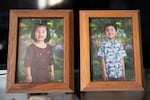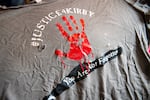Editor’s note: This story contains graphic details of police violence.

Cody Whiterock, a 39-year-old father of two and citizen of the Shoshone-Paiute Tribes of Duck Valley Indian Reservation, died when he was shot and killed by a Bureau of Indian Affairs police on March 2, 2024.
Courtesy of the Whiterock family
Cody Whiterock was running for his life — the Bureau of Indian Affairs police had come for him again.
He’d been drinking at a friend’s bunkhouse on a farm in Owyhee County, Idaho, south of Boise, but the farm’s owner wanted him out and called 911.
When BIA police came, Whiterock did what he’d done before — he fled in his car, a BIA officer confronting him at gunpoint.
But this time, his car became stuck in the snow. He ran into the sagebrush prairie, a second officer chasing after him in the gusting wind, according to public records and interviews with the Whiterock family.
What followed next was an 80-minute foot pursuit, and by the time it was over, Whiterock was dead — face down in the snow, shot four times in the face and chest.
More than a year later, Whiterock’s grieving family is still searching for answers about his death, but they’ve heard virtually nothing from the agency that killed him.
The BIA has not told the family about the circumstances surrounding the shooting or the names of the officers involved. The BIA hasn’t even publicly acknowledged that the March 2024 shooting occurred.
An investigation conducted by Idaho State Police remains open — and police and coroner reports make no mention of Whiterock having a weapon on him when he was killed.
Whiterock, 39 when he died, was not the first in his family to be killed by BIA officers in recent years: His cousin, Kirby Paradise, was killed by BIA officers in 2020. Paradise’s death was never reported publicly by either the media or the BIA, and the family faced a similar wall of silence surrounding the circumstances of his death.

Kirby Paradise left behind two children when he was shot and killed by Bureau of Indian Affairs police in his home on the Fort McDermitt Indian Reservation in September 2020.
Courtesy of the Paradise family
Like other families whose loved ones have been shot and killed by BIA officers, Whiterock’s family has encountered an agency that operates as a black hole of information, rarely communicating any information to families or the public and providing no public accounting of the circumstances of deaths at the hands of officers.
Amid a nationwide reckoning over police use of force, the BIA has largely evaded widespread or public scrutiny of its policies. In response to questions from InvestigateWest, the BIA said it is in compliance with all federal reporting requirements surrounding in-custody deaths, but did not respond to follow-up questions regarding details in Whiterock’s and Paradise’s killings.
Existing data shows Native Americans face the highest risk of deadly police violence in the United States — between three to five times the rate that others face. And that data is likely an undercount of the true figures.
Deaths at the hands of BIA police are rarely reported publicly, particularly if they occur on tribal land, and gaps exist in data meant to record in-custody deaths.
For 2020, the BIA confirmed to InvestigateWest that it reported zero arrested-related deaths to the Department of Justice — despite killing two people that qualify for reporting. A lack of media attention means many killings of Native Americans by the BIA and other police agencies pass in silence.
The United States has trust and treaty responsibilities toward federally recognized tribes. To meet part of those obligations, the BIA provides direct law enforcement services to roughly 200 tribal communities through its Office of Justice Services.
Two of those communities are the Duck Valley Reservation, about 100 miles south of Mountain Home that shares geography with the border of southern Idaho and northeastern Nevada, where Whiterock lived, and the much smaller Fort McDermitt Reservation 110 miles to the west, where Paradise lived.
That means BIA police, rather than state or tribal police, patrol the reservation and investigate crimes — a relationship complicated by the 200-year-old agency’s historic role as the enforcement arm of the United States’ anti-Native American policies.
Whiterock’s and Paradise’s deaths reignite concerns that not only are BIA police failing to report some in-custody deaths entirely, but that the agency faces less scrutiny than state or local police for killing people.

Bureau of Indian Affairs police killed Cody Whiterock outside of reservation boundaries. at this field in Owyhee County, Idaho.
Courtesy of the Whiterock family
Legal experts also question the BIA officers’ authority to pursue Whiterock outside reservation boundaries. BIA officers generally don’t have jurisdiction outside tribal lands, and the BIA has no official agreement with Idaho law enforcement to do so.
“BIA Police were dispatched to assist local law enforcement in the apprehension of an intoxicated individual trespassing on private property. BIA officers are authorized to assist other state and local agencies as necessary pursuant to their obligation as peace officers,” the agency said in response to questions from InvestigateWest.
Critics say the agency is operating without sufficient oversight.
“These are federal government entities that are on tribal lands that are arresting and killing people,” said Maren Machles, a researcher who studies in-custody deaths at the Project on Government Oversight, a nonpartisan government watchdog group.
“There’s a responsibility to figure out why people are dying in their custody, and it’s not even remotely being looked into, and it’s just enraging.”
Public records, obtained from state and county agencies by InvestigateWest, provide new details into the circumstances of Whiterock’s and Paradise’s deaths. While the records provide the family with some answers, the reports also raise new concerns — like why was Whiterock chased for so long, or why was Paradise shot five times in the back?
Critics say that the cases are a snapshot of underreported instances of violence against Native Americans by BIA police officers.
“I see it as an epidemic,” said John Heenan, a lawyer who has brought multiple lawsuits against the BIA on behalf of Native American clients.
Related: ‘A different standard’: Native Americans still searched at far higher rates by Washington State Patrol, new data shows
Underscoring the lack of transparency, government oversight and legal experts say the incidents raise serious concerns about compliance with federal laws on reporting in-custody deaths, since Paradise’s death was never reported to the Department of Justice as required.
The BIA contends Paradise was not in custody at the time of his death, and therefore did not report it — but the Death in Custody Reporting Act is meant to include individuals killed during the process of an arrest, like Paradise.
“I just don’t know how you can get closer to what the answers are when the BIA is being so secretive,” Machles said.
An 80-minute fatal foot chase
It was around 1 p.m. on March 2, 2024, when Devona Dosatimbe heard from a family member: The BIA police had shot and killed her little brother, Whiterock.
She and her sister rushed to her truck, zipped off tribal land and up Idaho Route 51 into Owyhee County, Idaho. It was full of police directing traffic. An officer waved them away, saying police couldn’t release any details.
They sat along the road for hours, pleading for information about their brother, only to leave without knowing for sure if he was alive.
They drove back home to the Duck Valley Reservation, 290,000 acres of tribal land home to the Shoshone-Paiute Tribes in the Owyhee Desert. She remembered her happy, goofy brother — how they loved riding horses together so much they’d rush home from school, hop on their horses and race off, galloping amid the sagebrush and riding until sunset.
It was only when Dosatimbe spoke with the county coroner later that evening that a government official confirmed the devastating news that her brother had been shot by BIA police. Whiterock worked at tire shops and was a father to two teenage sons.
The BIA’s history in tribal communities is fraught with abuses by the agency, making trust difficult for many Native Americans.
The agency was first housed under the War Department, and its agents were enforcers of 150 years of federal policies to terminate, assimilate and forcibly relocate Native Americans. Its priorities have shifted in the last 50 years, and the agency and tribes work closely together on a number of issues including land management, law enforcement and fiduciary services.
Despite the shift, the lasting legacy of the agency’s sordid past is fresh in the minds of many in tribal communities.
At the Indian Police Academy in Artesia, New Mexico, the handbook says that their goal is to uphold the U.S. Constitution, a top-down view of tribal governance that some tribal officials say retains the paternalistic role of the agency’s past.
A majority of BIA police officers are not from the communities they police, and officers rarely interact with the community outside of their law enforcement roles, some families say.
BIA police had pursued Whiterock in the past — including the night before his death when he avoided capture. Whiterock had an outstanding warrant in Idaho for resisting and evading arrest from the month before his death.
Since Whiterock’s killing, the BIA has never publicly acknowledged his death. Because it occurred on state land, the Idaho State Police released a short statement on March 4, 2024, acknowledging a man had been killed while fleeing BIA police officers in Owyhee County. A few days later, the Idaho Statesman published his name.
Public records provide previously unknown details about Whiterock’s death. But to Whiterock’s family, it doesn’t exactly add up.
At 8:48 a.m. on March 2, 2024, according to dispatch records, Owyhee County dispatch got the first call. There was an “intoxicated subject” who refused to leave, and it included his name: Cody Whiterock. BIA police radioed back and two BIA officers were first to respond.
At 9:15, the BIA arrived and encountered Whiterock, who was in his car “trying to leave.” He had a statewide warrant in Idaho out for his arrest, and BIA police say Whiterock eluded a different officer during a separate car chase the night before his death.
In an incident report, an officer claims that Whiterock attempted to flee again on March 2, “almost hitting the officer” who got out of his truck and approached Whiterock’s car at gunpoint.
Whiterock’s car slid off the road, becoming stuck. He got out and ran. The second BIA officer chased after him, telling him to stop, the report says.
At 10:02, that officer was still chasing Whiterock on foot. At some point, there was a physical confrontation between Whiterock and the officer, in which the officer says he “unsuccessfully” deployed his taser twice.
The report states Whiterock “pushed the officer on his back and was trying to grab something on his waist,” though it’s unclear whose waist the officer is referring to. The officer then says he removed the duty rifle slung on his shoulder and hit Whiterock in the face with it. He claimed Whiterock “continued aggressing.”
At 10:41, the officers called for “a body bag.”
The BIA officer had shot Whitework four times in the face and chest with the rifle.
There were no witnesses mentioned besides the two BIA police officers.
It took Owyhee County deputies nearly two hours after the initial call to get there — it’s about 80 miles away from the closest state police station. Whiterock lay face down, covered in a thin layer of fresh snow.
Whiterock was unarmed, according to the incident report and a coroner’s report.
Related: Washington state courts slow in vacating hundreds of thousands of illegal drug convictions
According to a memorandum of understanding between the BIA and FBI, the FBI is responsible for taking the primary role in investigating any officer-involved shootings by BIA police. But the FBI declined to respond or investigate Whiterock’s death, according to the report.
It’s unclear why the FBI declined to investigate, and the BIA did not respond to requests for more information. The FBI did not respond to a question about why it declined to investigate Whiterock’s killing.
Whiterock’s death has left his family with a host of unanswered questions.
“Cody hasn’t always been the model citizen, and we all know that, you know, like he’s had problems in the past,” said his sister, Dosatimbe.
“But that doesn’t mean that whatever happened to him gave them the right to basically shoot him because, according to the news, they said that my brother was running away from them. So why would they even shoot?”
Dosatimbe says that if it is proven her brother was at fault, she would accept that it cost him his life. But she hasn’t been able to get those answers due to the opacity surrounding the case.
She’s been to the spot where her brother was killed and doesn’t understand how the officer spent more than an hour chasing him just a few hundred yards in a field full of sagebrush.
Dosatimbe said the Idaho State Police told her that they would be investigating the incident, something also reflected in the dispatch log. The State Police denied public records requests related to the Whiterock case from InvestigateWest citing an ongoing investigation.
“We’re being left in the dark,” Dosatimbe said. “It’s almost like, whatever happened, they kind of, like, want to sweep it under the rug.”
Death of a son

Undated photo of Kirby Paradise, left, dressing up as Santa Claus during Christmastime.
Courtesy of the Paradise family
Like the Whiterock family, the family of Kirby Paradise, his cousin, knows little about the man’s death. The details are being made public for the first time through public records obtained by InvestigateWest. InvestigateWest obtained public records in Paradise’s case through state and county agencies in Nevada.
Paradise lived in a gray, single-wide trailer on the Fort McDermitt Paiute and Shoshone Tribe Reservation, which shares geography with southern Idaho and northern Nevada.
The Fort McDermitt Reservation is called the sister reservation of the Shoshone-Paiute Tribes of Duck Valley Reservation, since the communities there share relatives and culture that predate the existence of reservations.
Paradise had two children, a boy and a girl under 10. He once dressed up as Santa Claus for the tribe’s annual Christmas event for children and was described by loved ones as a quiet and generous man who enjoyed hunting and fishing.
“He’d give you the shirt off his back,” said Cletus Paradise, his father.
Though close in age, their families say Whiterock’s and Paradise’s personalities set them apart — Whiterock was boisterous and goofy, while Paradise was shy and kind. Just three years apart, Whiterock and Paradise spent a lot of time together at the Paradise household when the family lived in Boise for a period and the Whiterock family visited often to spend weekends BMX biking.

Photos of Kirby Paradise’s children are seen Saturday, April 19, 2025, at Cletus Paradise’s home on the Duck Valley Reservation.
Drew Nash / InvestigateWest
Later, the Paradise family moved back to the Fort McDermitt reservation, one of the 14 tribal communities served by the Western Nevada Agency branch of the BIA law enforcement. The regional office, based in Carson City, Nevada, deploys officers to police the communities under its jurisdiction.
Around midnight on Sept. 24, 2020, a solo BIA police officer went to Paradise’s home to investigate a report of domestic violence involving Paradise and his girlfriend. Paradise was reported to be the aggressor.
According to an incident report from Nevada’s Humboldt County Sheriff’s Office, there was an argument between Paradise and the BIA police officer, whose name has not been publicly released.
Paradise came out of his home holding what the BIA officer believed to be a real firearm — it was a BB gun — and pointed it at his own head several times. The officer claims Paradise threatened him and pointed the gun at him.

A Walther PPK 4.5mm caliber CO2 air pistol sits in an evidence box, April 19, 2025.
Drew Nash / InvestigateWest
According to a Washoe County autopsy report, Paradise was shot twice in the chest, three times in the left arm and five times in the back. Paradise was found face-down inside his home, and photos of the scene reviewed by InvestigateWest show bullet holes in the freezer on the wall as well as in the home’s floor.
Of two reports on the incident, neither explains how the confrontation between Paradise and the officer outside moved inside to where Paradise was found.
The BIA never reported Paradise’s death publicly — it wasn’t required to. Because it took place on the reservation where the BIA has jurisdiction, no other police agency reported that the shooting occurred.
However, federal law did require the BIA to include Paradise’s death in 2020 reporting on arrest-related deaths to the Department of Justice — but the BIA reported zero arrest-related deaths that year nationwide.
Like the Whiterock family, the Paradise family knows little about his death. The FBI conducted an investigation into his son’s death by a BIA officer, but the agency refused to release or confirm the existence of any related records to InvestigateWest.
“It’s just mind blowing,” Cletus Paradise said. “With Cody, he’s my first cousin. More or less, in our people’s ways, he was my little brother — and it’s a shock to me, like two years apart, I lose my son, then I lose my little brother the same way, you know, at the hands of the BIA.”

Cletus Paradise continues to grieve his son, Kirby, nearly five years after Bureau of Indian Affairs police shot and killed him.
Drew Nash / InvestigateWest
Undercounted
For the year 2020, the year BIA police shot and killed Paradise, the agency reported zero “arrest-related” deaths to the DOJ. BIA police also shot and killed a second man, Brandon Laducer, a citizen of the Turtle Mountain Band of Chippewa on Aug. 23, 2020, during a confrontation in the man’s home on the Turtle Mountain Reservation, which shares geography with North Dakota.
It’s not clear if the BIA reported Whiterock’s death to the DOJ — the BIA has not yet produced the records for 2024 in response to a records request.
“The BIA can confirm that zero arrest-related deaths for the year 2020 were reported under federal reporting guidelines. At the time of the incident involving Mr. Paradise, he was not in the custody of the BIA; therefore, the incident did not qualify as an ‘arrest-related death,’” a spokesperson for the BIA said in response to questions from InvestigateWest.
A federal law meant to track in-custody deaths, called the Death in Custody Reporting Act, or DCRA, requires states and federal agencies to report the number of deaths that occur in their custody, including arrest-related deaths, to the federal government — but the rigor of reporting differs among state and federal agencies.
The law states federal agencies must report all deaths of people “detained, under arrest, or in the process of being arrested by any officer of such federal law enforcement agency” to the U.S. Department of Justice once every fiscal year. The agency must include some basic information about each deceased person and the circumstances of their death along with the report.
States face a similar but more intensive requirement under DCRA: They must report in-custody deaths to the state Attorney General each quarter. But absent a written cooperative agreement with state and local police, BIA police are beholden only to the federal DCRA standard of annual reporting. Whiterock’s death was not included in state-level DCRA data.
In 2021, an independent audit revealed serious flaws in how the BIA investigates deaths at tribal jails it oversees.
The audit was conducted by Darren Cruzan — a former BIA official with close ties to the agency and head of the Cruzan Group, a consulting firm — and reviewed 16 deaths between fiscal years 2016 and 2020, including nine that occurred during Cruzan’s tenure overseeing the BIA’s law enforcement division.
Despite Cruzan’s ties to the agency as its former top cop, the audit identified significant problems in the “effectiveness and thoroughness” of BIA’s internal investigations.
A January report from the Office of the Inspector General found the BIA “failed to identify and address potential conflicts of interest when awarding a contract” to the Cruzan Group.
Among the numerous areas for improvement identified in the audit were inconsistent reporting procedures, failure to comply with investigative timelines and missing documents.
This audit, when compared by Machles to the data the BIA submitted under the Death in Custody Reporting Act, revealed a total of five deaths in 2016 and 2017 that the agency did not report to the DOJ.
Since the audit reviewed only “closed” investigations, which take more than a year on average, there may be other deaths unaccounted for. The BIA did not respond to questions about the audit.
“These deaths are just a small percentage of what could actually be happening,” Machles said.
In 2022, in response to the audit, the BIA’s Office of Justice Services, which is the arm of the agency responsible for overseeing its law enforcement division, announced a series of reforms to its justice services, including “developing a standard operating procedure for in-custody deaths,” sending its internal affairs officers for additional training, and taking steps to “identify employee misconduct and clearly document in-custody death investigations.”
It also called for an updated memorandum of understanding between it and the FBI for internal investigations, which was published in late 2022, and affirmed the FBI’s lead role in investigating BIA in-custody deaths.

Cletus Paradise and his family memorialized their deceased son Kirby after he was shot and killed by BIA police in September 2020.
Drew Nash / InvestigateWest
Heenan, the lawyer, is currently suing the BIA in a separate case related to the alleged wrongful death of a Cheyenne man named Arlin Bordeaux who was killed on Dec. 2, 2021.
Bordeaux was killed by a BIA police officer after he was tased, pepper-sprayed, beaten with a baton and shot three times in the back in Lame Deer on the North Cheyenne Indian Reservation, which shares geography with Montana. Federal authorities declined to prosecute the officers who caused his death.
“Certainly these issues, I think, are not state specific — I think they’re BIA specific,” Heenan said.
To obtain information about a person’s death by BIA police, their loved ones must navigate the complex federal bureaucracy surrounding these types of investigations. If a family chooses to sue for wrongful death, they must do so in federal court, rather than state court.
Wrongful death lawsuits against the federal government generally don’t have a jury trial, so the verdict in such a suit against the BIA is being made by a judge, another federal employee.
“People, just by virtue of being on reservations, just don’t have the same rights and remedies as other U.S. citizens off-reservation have,” Heenan said.
Piecing it together
Dosatimbe recently returned with Whiterock’s sons to the spot where her brother died to honor him and his memory as she grieves and waits for closure, standing amid the sagebrush where they spent so much time as children. She’s waiting to hear what comes of the state police investigation into his death.
For the Paradise family, it’s been a four-year saga searching for answers that amounted to little — except feeling spurned by law enforcement. Well-known by many in the Shoshone and Paiute communities in the region, the deaths of Whiterock and Paradise leave more questions than answers.
“Nobody would tell me anything,” Cletus said. “It was like I had leprosy or something.”
Cletus appealed multiple times to the FBI agent on his son’s case for information, only to be denied. He tried filing Freedom of Information Act requests but was denied again. The FBI cited the personal privacy rights of Paradise and the disclosure of law enforcement investigative techniques in denying records to InvestigateWest.
“They’re supposed to be the top police agency in the United States. They should be open and honest,” Cletus said.
In the absence of official answers, Paradise’s family took it upon themselves to try to piece together what happened.
Cletus took photos of bullet holes in the home’s freezer and elevated porch with his phone, and he and his surviving son, Justin, collected spent casings from the bullets used to kill Kirby that were left behind by investigators.

Bullet casing and slugs were delivered back to Cletus Paradise after his son was shot to death by the Bureau of Indian Affairs.
Drew Nash / InvestigateWest
Cletus tried to give them to the FBI by speaking with the agent in charge during the investigation, but said the agent refused, telling Cletus he already had all he needed, and Cletus could toss the casings out.
So far all he’s gotten from the FBI is his son’s belongings and a sealed white box, wrapped in red tape reading “EVIDENCE.” Inside it is the black BB gun that got his son killed.
The box sat in his closet for nearly four years. With officials no longer looking for answers, he didn’t know why he’d held on to it for so long.
But he couldn’t bear to open it.
Cletus finally opened it on a sunny afternoon in April, in his home on the Duck Valley reservation.
Discussing his son, he thumbs through memories: A photo of Kirby staring intently at the camera. Another of the cake from his memorial. The spent slugs. A hand-drawn sketch of the scene of his son’s death.
Cletus gazes at a worn, gray T-shirt he’s draped on the couch — it’s emblazoned with the words:
“Justice4Kirby. You are not forgotten.”

A shirt, printed with words “#JUSTICE4KIRBY” and “You Are Not Forgotten,” was made after Kirby Paradise was shot and killed.
Drew Nash / InvestigateWest
InvestigateWest (investigatewest.org) is an independent news nonprofit dedicated to investigative journalism in the Pacific Northwest. Reporter Melanie Henshaw covers Indigenous affairs and communities in the region. Reach her directly at melanie@investigatewest.org or by phone or Signal at (971) 258-0891.
This republished story is part of OPB’s broader effort to ensure that everyone in our region has access to quality journalism that informs, entertains and enriches their lives. To learn more, visit opb.org/partnerships.